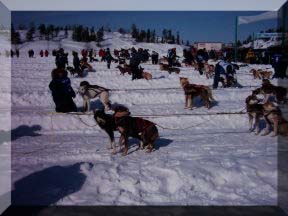
Wow, three in less than a week. I guess that's what happens when I get my hands on a digital camera at the same time as there's lots going on. I didn't even get to the Western Canadian Cross Country Ski Races this past weekend, which were also here in Yellowknife, and I didn't get back to the Snow King's castle to get some digital shots. I should have done that yesterday, but I didn't think of it, even when we were out on the lake.
Mike had heard that the start to the dog derby was impressive, which I guess should be no surprise when you take 16 teams times 8-10 dogs per team. That's a lot of very hyper, energetic dogs in one place. I had hoped to see a bit more of the derby over the weekend anyway, so I was glad that Mike was interested too. We got to the starting point about 15 minutes before the final race was due to begin, which gave us lots of time to take some pictures and pick out a good spot for catching the start of the race.

The race was started with a gunshot and the wave of a flag made with a broken hockey stick. Apparently it's part of the tradition. Most of the teams were off and running immediately, but a few teams weren't quite ready and left a bit later. One of these was Sam Perrino of Yellowknife in bib #1. Sam did well on the first two days and has been one of the top finishers for the last few years. The brief delay he had leaving the start didn't matter over the course of the 50-mile run - Sam finished third for the day as well as third for the entire 3-day, 150-mile derby. Here's Sam at the beginning of day 3.
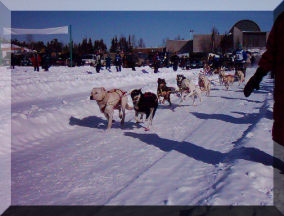
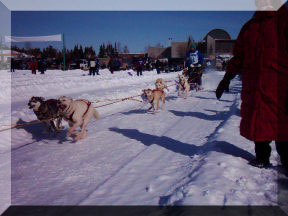
Here's a shot of Brian MacDougall and his team from behind.
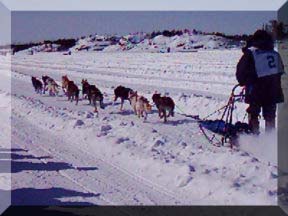
Once all the teams have left the start, many spectators (ourselves included this year) hop into their vehicles and drive to checkpoint 1, which is where the derby trail crosses the Dettah ice road on Yellowknife Bay. There's enough time to get to the checkpoint about 10 minutes or more ahead of the dogs, park, and get in position again. Here's some of the vehicles parked on the ice road near the checkpoint (we're probably about 2 km from the shore where the ice road starts) and the sign marking the trail.
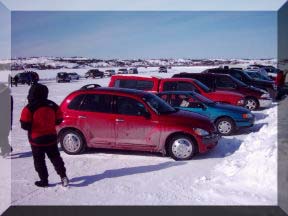
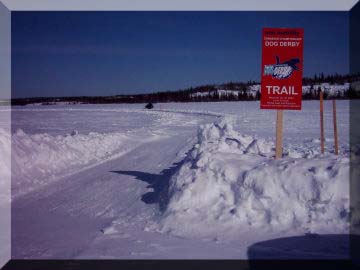
By checkpoint 1, Sam Perrino had already passed several mushers.
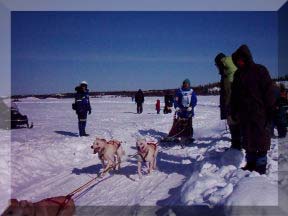
Here is Trevor Lizotte, who finished 13th overall, approaching checkpoint 1.
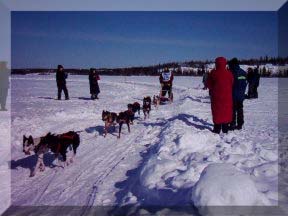
Here are some pictures of different variations on the modern racing sled. It has apparently gone through a fair bit of evolution and even here you can see the differences in design and construction.
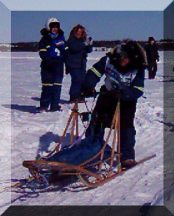
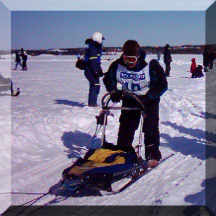
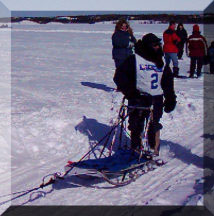
Gwen Holdmann of Fairbanks, Alaska, was the only woman in the derby. She finished 9th in a field of 16 teams. Here she passes through the crowd on the iceroad at checkpoint 1.
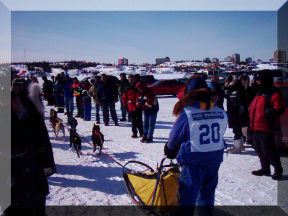
It has been a number of years since any racers used straight line harnesses on the dogs. All these dogs wore racing harnesses, which you can see here with their diamond pattern and rear clip to the line. The main force is on their chest and shoulders, where you can see the harness is padded, and the line to the sled has some stretch to it. You can also see the musher in the first picture using his leg to help push, which is called pedalling and apparently can be almost like having an extra dog on the team if you do it right.
In the second picture, the thing to remark (other than the harness) is the pointer in the first pair of dogs. It's hardly what you'd expect for a sled dog, is it? I believe this dog is out of the Beck kennels - we did see a pointer bitch there with her litter of puppies when we went dogsledding in late November. The dogsledding book I bought at the derby says there was some experimentation with crossing traditional sled dog breeds with hounds for a while. However, the book also said that most mushers had given up the hound crosses because they found them less trainable and predictable, plus many of them got cold too quickly on the traplines for those who were also using them as regular working dogs. I guess there's still a few being used, since I saw at least one pointer or pointer mix in the derby.
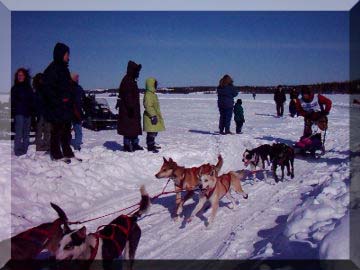
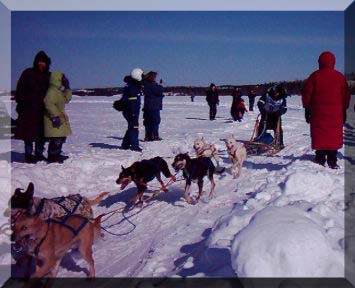
Here's a shot of some more non-traditional dogs on a different team. I know you can't see the black one very well, but the legs alone look more hound than husky. The second dog may be part greyhound, which was one of the hounds used for cross-breeding, but it's hard to say for sure from this picture. It certainly has the same rangy look, shorter hair, and longer nose.
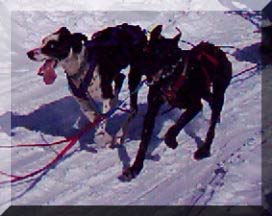
So overall, there were 16 mushers, 14 of whom finished the 3-day derby. Most were from the Territories, especially the Yellowknife area, and 5 of the mushers were Becks - certainly a dominant family in local dog racing if not international competitions. First place went to Buddy Streeper of Fort Nelson, BC, second was John Beck of Yellowknife, and third was Sam Perrino of Yellowknife. These three were also the top three in 2002, only last year it was 1-John, 2-Buddy, 3-Sam.
I don't have results for any of the other events like the Heritage Race and the strong dog pull, although I did hear that the weight for the pull got up quite high. Maybe it will be in the paper this week.
In case you're interested, first prize for the Canadian Championship Dog Derby is $10,000. Not bad, huh?
Okay, speaking of dogs, I think mine wants to go out and then go to bed. G'night all.
Jan